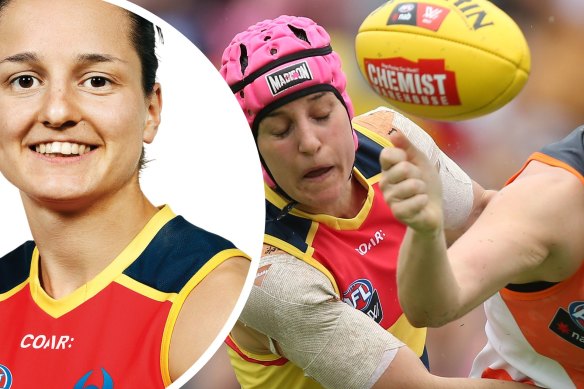This was published 1 year ago
AFLW player becomes the world’s first female athlete to be diagnosed with CTE
By Carla Jaeger
AFLW premiership player Heather Anderson has become the world’s first female athlete to be diagnosed posthumously with CTE, a degenerative brain disease caused by repeated head injuries.
The landmark diagnosis came after Anderson’s family donated her brain to researchers to better understand the circumstances of the 28-year-old’s death.

The late AFLW premiership player Heather Anderson has become the world’s first female athlete to be diagnosed with CTE. Credit: The Age
Anderson, who died from suicide in November, played eight games for the Adelaide Crows in the inaugural AFLW season in 2017. Her death is being investigated by a coroner.
Her professional football career ended at age 23 that same year, when she reluctantly retired from the top level after a second serious shoulder dislocation in the 2017 AFLW grand final. She went on to continue her role as a medic in the Australian Defence Force.
Following an autopsy, researchers confirmed Anderson met the criteria for low-stage CTE after discovering three lesions on her brain – a very abnormal finding for someone Anderson’s age.
The findings from Anderson’s autopsy were published in a Spring Medical Journal report, which urged for better policies to prevent traumatic brain injuries as female contact sports continue to increase in popularity.
Michael Buckland, a neuropathologist and founder of the Australian Sports Brain Bank, was a co-author to the report.
“I’ve had this sort of growing sense of alarm ever since I started [researching CTE],” Buckland said. “It’s like ‘holy crap, how big is this problem?’ We have no idea.”
Chronic traumatic encephalopathy (CTE) is a degenerative brain disease that is not dissimilar to Alzheimer’s. It can only be determined via an autopsy, and was found to exist in the brains of VFL/AFL players Graham “Polly” Farmer, Danny Frawley and Shane Tuck.
Athletes who play contact sport, particularly from an early age, are at an increased risk of the disease. While Anderson is the first female athlete to be diagnosed, the researchers said more CTE diagnoses are “likely” in the coming years, pointing to the surge in participation in professional women’s sports leagues.
The report also pointed to research that indicates female athletes are more susceptible to concussion than their male counterparts.
Anderson did not present any obvious symptoms of CTE. She did not behave unusually, have substance problems, or show signs of depression in the months before she died.
There was not enough evidence to know whether the disease had contributed to Anderson’s death, the report found. However, it concluded: “It nevertheless illustrates the need to consider forensic examination of the brain in suicide deaths where there is a history of repetitive head trauma.”
During her AFLW career, Anderson suffered one concussion – but her family suspected she endured at least another four concussions that went undiagnosed.
“What correlates best with your risk of CTE is not the number of concussion you get, it’s the number of years of contact sport played,” Buckland said, who co-authored the report.
‘I’ve had this sort of growing sense of alarm ever since I started [researching CTE],’ Buckland said. ‘It’s like “holy crap, how big is this problem?” We have no idea.’
Neuropathologist Michael Buckland
Anderson had been playing contact sports for 18 years, after she began playing rugby when she was five.
“It’s not only the concussions, but also the hundreds of other impacts that don’t give you signs of concussion, but they’re probably also doing very subtle microscopic damage to the brain,” Buckland said.
The neuropathologist is pushing for sports codes to have specific CTE prevention policies alongside their concussion protocols.
“They’re not the same thing,” he said. The preventative polices, said Buckland, should delay and reduce the lifetime exposure to repeated head impacts.
In March, the AFL recognised the link between head trauma and the degenerative brain disease CTE in its official submission to a Senate inquiry. However, the code said the association between head trauma and long-term psychological health is less clear.
“We don’t fully understand what impact CTE is having on our society.”
Anderson, a quietly spoken defender, was famed for not only her work ethic but the pink helmet she wore to help her vision-impaired mother spot her on the field.
The Adelaide Crows and the AFL Players Association chose not to comment.
If you or anyone you know needs support call Lifeline on 131 114.
Keep up to date with the best AFL coverage in the country. Sign up for the Real Footy newsletter.